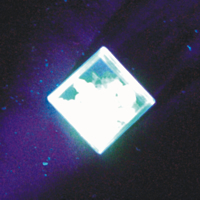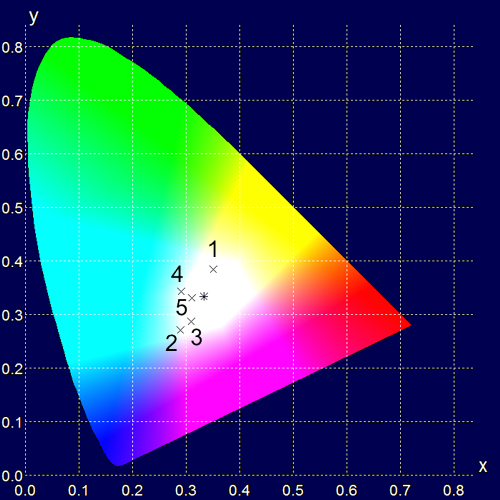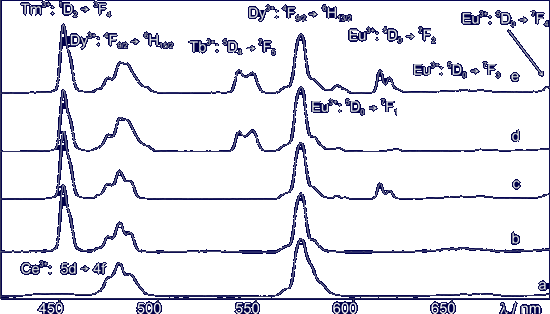| White Light :: | |||||
|---|---|---|---|---|---|
White Light Sources |
 |
||||
| Fig. 1: Two typical spectral distributions of fluorescent tubes. The mercury lines are marked with Hg and a letter in brackets, the reddish fluorescent peaks are marked with "F". | |||||
| White light crystals and microcrystals Dy,Tm-; Eu,Dy,Tm-; Tb, Dy, Tm- and Eu, Tb, Dy, Tm co-doped Gadoliniumaluminiumborate (GAB) or Yttriumaluminumborate (YAB) crystals and microcrystalline powders show the desired effect. It should be emphasised that the white impression results from luminescence of the rare earth ions only and does not require the presence of mercury emission bands.White light has already been obtained with similar materials like Ce,Dy:GAB or Tm,Dy:YAB (see Fig. 2). Exchanging Ce3+ with Tm3+ increases the colour rendering of the emitted light, and a further addition of Tb3+ results in a greenish white, whereas an addition of Eu3+ leads to a phosphor with a reddish white emission. When both Tb3+ and Eu3+ are added, a polychromatic white phosphor can be obtained, whose chromaticity co-ordinates are closest to the white point whilst intensity and colour rendering index are highest (next to Eu,Dy,Tm:GAB(2,3,2)) when compared to the other phosphors presented. The CIE1931 xy chromaticity co-ordinates of the phosphors under 390nm excitation are depicted in Fig. 3, the emission spectra of the phosphors described above are given in Fig. 4, including the Russell–Saunders terms of the respective emission bands. |
 |
||||
| Fig. 2: Dy,Tm:YAB(4%,5%) crystals in a transparent box. Excitation source: high pressure Hg UV lamp, 390 nm UV filter. | |||||
 |
|||||
| Fig. 3: CIE1931 xy chromaticity co-ordinates of Ce,Dy:GAB(4,3) (a), Dy,Tm:GAB(3,2) (2), Eu,Dy,Tm,GAB(2,3,2) (3), Tb,Dy,Tm:GAB(2,3,2) (4) and Eu,Tb,Dy,Tm:GAB(2,2,3,2) (5) upon 390nm excitation (all marked with an ×). The asterisk marks the position of the white point. | |||||
 |
|||||
| Fig. 4: Emission spectra of Ce,Dy:GAB(4,2) (a), Dy,Tm:GAB(3,2) (b),
Eu,Dy,Tm:GAB(2,3,2) (c), Tb,Dy,Tm:GAB(2,3,2) (d) and Eu,Tb,Dy,Tm:GAB(2,2,3,2) (e) upon 390nm excitation. |
|||||
| A series of emission spectra with excitation from 350 to 370nm is given in Fig. 5. In order to simulate a technical application like down-conversion for UV LEDs, the excitation was relatively broad (15 nm spectral band width). As can be seen from Fig. 5, the variation of the excitation wave length results in different intensity distributions of the emittion ions. Therefore, the colour temperature of the emitted white light can be adjusted by variation of the excitation wavelength. | |||||
 |
|||||
Fig. 5: Emission spectra of Eu,Tb,Dy,Tm:GAB(2,2,3,2), excitation from350 to 370 nm, 15nm excitation band width |
|||||
Polycrystalline sub-micron-sized GdAl3(BO3)4 phosphors
doped with rare-earth ions have been prepared by combustion
synthesis with urea. Whereas Dy,Tm:GAB(3,2) exhibits a higher
colour rendering index (Ra = 30) than Ce,Dy:GAB(4,3) (Ra = 3),
Eu,Tb,Dy,Tm:GAB(2,2,3,2) reveals even more advantages. In addition
to Dy3+ and Tm3+, this material shows the highest emission
intensities of the phosphors investigated herein. A total of seven Literature: Links: |
|||||